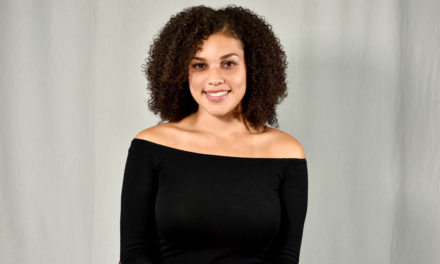As a dark-skinned, size twelve, black woman, I’ve grown perplexed by the images of African American women in the media. On television and in magazines, black women are a size two with hair down their back and light skin resembling that of a white woman. Dark-skinned women are usually shown with some type of natural hair. Granted, black comes in many sizes, shapes, and colors, but there seems to be a one-dimensional spectrum, with two radical extremes at both ends.
Essence Magazine’s Best Dressed Women of 2008, consisted of twenty, stunning women, but not one of them looked like me. Everyone was either thin and of a lighter complexion, like Lauren London and Keri Hilson, or they were of larger stature, like Oprah and Queen Latifah. All these women are undeniably beautiful, but there has to be a middle ground.
The average female in the United States is a size fourteen and ironically, plus size apparel begins at a size fourteen. In a warped society of style, size, and appearance, I believe it’s only fair to throw in a more even perception of women of color. In my opinion, the media is not the only source of blame in this situation. The light-dark complex dates back to slavery. Lighter women worked in the house, cooking and cleaning, while slaves with darker skin tones worked on the farms and in the fields. Our ideas and perceptions within the community haven’t changed much since those times. Light skinned women are considered superior and more beautiful than dark skinned women. All my life I’ve heard comments and cliches like, “you’re pretty to be dark skinned,” and “so and so is black and ugly.” It often makes me wonder if people truly believe this way or if it’s just a subconscious bruise left from our past? This ideal has ravaged the identity of our community and is damaging the world’s view of African American women.
In 2007, Beyonce posed for Sports Illustrated Swimsuit Edition. In a tasteful spread, the superstar dons blonde highlights with an ultra-thin body and unusually light skin. While walking past the magazine stands, you had to do a double-take to recognize her. In October 2008, she was on the cover of Essence magazine with much darker locks, browner skin, and a slightly larger frame. After seeing the contrast, I began to question if lighter skin and smaller frame are more profitable in the media. Was Beyonce being a sellout? Not, necessarily, perhaps, she was tailoring her image, as do many celebrities, depending on their audience.
So, the story isn’t always light and dark. According to Forbes, two of the fifteen world’s top earning models are women of color, Selita Ebanks and Liya Kebede. However, these lovely ladies were at the bottom of the list. Are they less attractive than their Caucasian and European counterparts? No. Are they less marketable in the fashion industry? Yes. Liya Kebede, Este Lauder’s first black model, ranked in at number 15 while Selita Ebanks, a Victoria Secret Angel is ranked number 13. In the grand scheme of things, black is black, but I wonder if Kebede, a brown- skinned model, would have made more money if she was a tad lighter.
Both celebrity and every-day women battle skin tone and size, but black men seem to have it a little easier. Socially, light and dark skinned men have gone in and out of style, but the media seems to treat black men in Hollywood quite fairly when it comes to appearances. Leading men like Will Smith and Denzel Washington, constantly drop and pick-up a few pounds here and there for roles, but are never talked about in tabloids or celebrity gossip shows.
Although confidence is up to each individual person, we have to think about the images shown to our younger generations. It’s about equal and honest representation. Only showing a few images out of many, perpetuates the stereotypes that create self-hate. Our skin tone is beyond our control and is one of the few things that cannot be altered. What is most important is being happy and healthy. Black is beautiful, no matter the shade. There should be neither prize nor penalty for being light or dark.





.
Since mention was made of the topic of the ‘house’
and the ‘field’ slave — I just wanted to note that
this false concept that so many people have
— that the lighter-complexioned chattel slaves
“had it easier” or “thought they were better”
than the darker-complexioned slaves -– and
/ or largely “relaxed in the big house” while
the darker-complexioned slaves “suffered
in the fields” — is very much (just like the
infamous ‘Willie Lynch Letter’ Hoax) all VERY
MUCH AN URBAN MYTH (and, is one which,
in nearly every way that’s possible, completely
defies the true historical recorded account).
The historical record shows that
those enslaved people who were of a
lighter-complexion (i.e. mulatto-lineage)
and that were found on the continental
United States during the antebellum
(chattel-slavery) era were actually treated
MUCH WORSE than were those enslaved
people who were of a darker-complexion.
In fact, the record shows that most of the White
people (especially the White women) tended
to look upon the lighter-complexioned slaves
as being mere ‘mongrels of miscegenation’
(resulting largely from the rapes caused by the
plantation ‘Overseers’); in their disgust at the
sight of these slaves — insisted that they
be “banished to the fields”; and also then
purposefully reserved most of the ‘big house’
positions (ex. mammy, cook, driver, etc.) for
the darker-complexioned slaves — who most of
the White people had perceived as being “more
loyal, more docile, less competitive, etc.”, and,
even more important, they were also of a skin tone
which could never cause them to be seen as being
any part-‘white’ (and even worse, perceived as
“possibly” also being “a member of the family”
–as it were– of a given plantation ‘Owner’).
And this maltreatment was generally even much
more so the case if the lighter-complexioned
enslaved person was even remotely ’suspected’
(by, say, a wife, sister or daughter — who ran
“the big house”, while a ‘male’ family member
ran “the plantation”)of possibly being the
offspring of a given plantation ‘Owner’
(or his son, or father, or brother,
or any other male found in the
plantation ‘Owners’ White family).
In addition, the few lighter-complexioned enslaved
people that were actually permitted to do any work
in the “big house” were (as a punishment for having
the lowly status of “mongrel” and in order to make
sure that they did not become “too uppity”) kept
under a much more severe work supervision (by both
the White women who ran the plantation household
and also by the darker-complexioned enslaved people
who had been placed over the lighter-complexioned
enslaved people and given various “rewards” in an
exchange for the promise to ‘keep an eye on’ them)
than were most of the (more trusted and seemingly
endeared) darker-complexioned enslaved people.
Books by Deborah Gray White; Paula Giddings; bell
hooks; J. California Cooper; William Wells Brown;
etc. expose the truth about the urban-myth and
show that the lighter-complexioned enslaved
people received NO special treatment and were,
instead (due to being seen as mere “mongrels of
miscegenation”) usually treated much worse than
were most darker-complexioned enslaved people.
The hatred, fear and mistrust that many of
the antebellum and post-antebellum era White
southerners felt toward the people who were
both of a light-complexion (mulatto-lineage)
and were also chattel-slaves, is very strongly
presented in the ‘D.W. Griffith’ racist film
‘Birth of a Nation’– where pretty much
all the trouble, tragedy and dangers found
experienced by White southern families in
the film is falsely presented as being
caused by “uppity” Mulattoes who ‘needed to
be taught “their place” among White people’.
(i.e. they “needed” to be beaten, raped, lynched,
etc. by the “proud” White people who had been
reared to make it clear that they felt
“no connection” to any non-White person).
Anyone who would like any additional information
on this topic can feel free to contact me directly.
Hope this information is helpful
& that everyone has a great day.
– AP (soaptalk@hotmail.com)
Related Links:
http://boards.mulatto.org/post/show_single_post?pid=34070161&postcount;=13
http://boards.mulatto.org/post/show_single_post?pid=34070414&postcount;=14
.